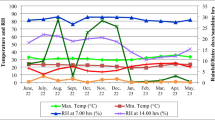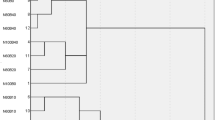Abstract
Ginkgo (Ginkgo biloba L.) is a traditional economic tree species in China, and often cultivated in agroforestry systems. The objective of the study was to examine the effects of different Ginkgo and crop species combinations on soil fertility. We established two Ginkgo and crop species systems: Ginkgo + wheat + soybean (G+W+S), Ginkgo + rape + soybean (G+R+S), and one Ginkgo + mulberry (G+M) system, one pure mulberry plantation (M), and one crop systems of rape + soybean (R+S) in the field. Soil chemical properties and enzymes activities were measured 4 years after planting. These soil chemical properties and enzyme activities were used as soil fertility indicators (FI). Soil fertility of the five planting systems was finally evaluated by using improved Analytic Hierarchy Process (AHP). The result showed that soil chemical properties (including pH, organic matter, total N, hydrolysable N, available P and K, total K) and soil enzyme activities (including catalase, sucrase, urease, dehydrogenase, phosphatase, polyphenol oxidase and protease) in the five planting systems were significantly different from each other (P = 0.0237). The above parameters were also different at different soil depths. The concentration of total N, P, organic matter, available P and K of soil decreased significantly with soil depth (P = 0.0146), however, pH increased. The concentrations of organic matter, total N, hydrolysable N, available P and K of soil under rape + soybean (R+S) was lowest among the five planting systems. The activities of sucrase, urease, dehydrogenase, phosphatase and protease decreased with soil depth, however, the activity of catalase and polyphenol oxidase increased. Except for catalase, the activities of these enzymes in the R+S system were the lowest among the five planting systems. The integrated evaluation of soil fertility showed that soil fertility indicators (FI) were significantly different, and the FI values for the five systems followed order: G+M (0.847) > G+W+S (0.446) > M (0.399) > G+R+S (0.343) > R+S (0.211). These results indicated that adoption of a Ginkgo-crop combination could lead to increased long-term sustainability of soil fertility by improving levels of soil organic matter, pH, available nutrient and soil enzyme activity.


Similar content being viewed by others
References
Akyeampong E, Hitimana L, Torquebiau E, Munyemana PC (1999) Multistrata agroforestry with beans, bananas and Grevillea robusta in the highlands of Burundi. Expl Agric 35:357–369
Allen SC, Jose S, Nair PKR, Nkedi-Kizza P, Ramsey CL (2004) Safety-net role of tree roots:evidence from a pecan (Carya illinoensis K. Koch)-cotton (Gossypium hirsutum L.) alley cropping system in the southern United States. For Ecol Manage 192:395–407
Andrews SS, Karlen DL, Cambardella CA (2004) The soil management assessment framework: a quantitative soil quality evaluation method. Soil Sci Soc Am J 68:1945–1962
Binkley D, Sollins P (1990) Factors determining differences in soil pH in adjacent conifer and alder-conifer stands. Soil Sci Soc Am J 54:1427–1433
Brejda JJ, Moorman TB, Karlen DL, Dao TH (2000) Identification of regional soil quality factors and indicators. I. Central and southern high plains. Soil Sci Soc Am J 64:2115–2124
Budiadi, Hiroaki TI, Sabarnurdin SM, Suryanto P, Kanazawa Y (2006) Biomass cycling and soil properties in an agroforestry-based plantation system of kayu putih (Melaleuca leucadendron LINN) in East Java, Indonesia. Agrofor Syst 67:135–145
Chander K, Goyal S, Nandal DP (1998) Soil organic matter, microbial biomass and enzyme activities in a tropical agroforestry system. Biol Fertil Soils 27:168–172
David AW (2002) Communities and ecosystems: linking the above ground and below ground components. Princeton University Press, New Jersey, pp 56–104
Dexter AR (2004) Soil physical quality. Part II. Friability, tillage, tilth and hardsetting. Geoderma 120:215–225
Gao XB, Liu ZW, Pan KW (2005) Preliminary studies on soil enzymes activities of typical forest ecosystem in Minjiang areas (in Chinese). J Northwest For Univ 20:1–5
Geng YQ, Bai CX, Zhao TR (2006) Soil enzyme activity and its relationship with the soil fertility in Badaling Mountain Area of Beijing (in Chinese). J Beijing For Univ 28:7–11
Guan SY (1986) Soil enzyme and its analysis method (in Chinese). Agriculture Press, Beijing, pp 135–137
Hartemink AE, Buresh RJ, Jama B, Janssen BH (1996) Soil nitrate and water dynamics in sesbania fallows, weed fallows and maize. Soil Sci Soc Am J 60:568–574
Hu YL, Wang SL, Yan SK, Gao H (2005) Effects of replacing natural secondary broadleaved forest with Cunninghamia lanceolata plantation on soil biological activities (in Chinese). Chin J Appl Ecol 16:1411–1416
Institute of Soil Science of Chinese Academy of Sciences (1981) Soil physical and chemical analysis. Shanghai Science and Technology Publishing House, Shanghai, pp 126–165
Jimenez MP, Horra AM, Pruzzo L (2002) Soil quality: a new index based on microbiological and biochemical parameters. Biol Fertil Soils 35:302–306
Karlen DL, Mausbach MJ, Doran JW (1997) Soil quality: a concept, definition, and framework for evaluation (a guest editorial). J Soil Sci 61:4–10
Kerstin M, Egbert M (2003) Response of enzyme activities to nitrogen in forest floors of different C/N ratios. Biol Fertil Soils 38:102–109
Li HS, Luo SM (2001) Effect of different typical slope land used patterns on soil physical & chemical properties (in Chinese). J South China Agri Univ 22:1–4
Li CX, Chen F, Wang JZ (2007) Effect of different tillage practices on soil enzyme activity (in Chinese). Chin J Soil Sci 38:601–603
Lin JY, Chen ZH (2000) Benefit analysis for the mixed orchard of Ginkgo and pear intercropped with different cash crops (in Chinese). Econ For Res 18:14–16
Mohsin F, Singh RP, Singh K (1996) Nutrient cycling of poplar plantation in relation to stand age in agroforestry system. Indian J For 19:302–310
Montagnini F, Sancho F (1994) Net nitrogen mineralization in soils under six indigenous tree species, an abandoned pasture and secondary forest in the Atlantic lowlands of Costa Rica. Plant Soil 162:117–124
Moscatelli MC, Fonck M, Angelis PD, Larbi H, Macuz A, Rambelli A, Grego S (2001) Mediterranean natural forest living at elevated carbon dioxide: soil biological properties and plant biomass growth. Soil Use Manag 17:195–202
Mugendi DN, Nair PKR (1997) Predicting the decomposition patterns of tree biomass in tropical highland microregions of Kenya. Agroforest Syst 35:187–201
Munoz E, Beer J (2001) Fine root dynamics of shaded cacao plantations in Costa Rica. Agrofor Syst 51:119–130
Pandey CB, Singh AK, Sharma DK (2000) Soil properties under Acacia nilotica trees in a traditional agroforestry system in central India. Agrofor Syst 49:53–61
Schroth G, Teixeira WG, Seixas R, Silva LF, Schaller M (2000) Effect of five tree crops and a cover crop in multi-strata agroforestry at two fertilization levels on soil fertility and soil solution chemistry in central Amazonia. Plant Soil 221:143–156
Singh B, Sharma KN (2007) Tree growth and nutrient status of soil in a poplar (Populus deltoides Bartr.)-based agroforestry system in Punjab, India. Agrofor Syst 70:125–134
Singh K, Chauhan HS, Rajput DK (1989) Report of a 60 month study on litter production, changes in soil chemical properties and productivity under poplar (P. deltoides) and Eucalyptus (E. hybrid) interplanted with aromatic grasses. Agrofor Syst 9:37–45
Szott LT, Fernandes ECM, Sanchez PA (1991) Soil plant interactions in agroforestry systems. For Ecol Manag 45:127–152
The Association of Soil Science of China (1999) The analysis of soil and agricultural chemistry. Agricultural science publishing house of China, Beijing, pp 48–56
Tomich TP, van Noordwijk M, Vosti SA, Witcover J (1998) Agricultural development with rainforest conservation: methods for seeking best bet alternatives to slash-and-burn, with applications to Brazil and Indonesia. Agric Econ 19:159–174
van Wambeke A (1992) Soils of the tropics. McGraw-Hill, New York, p 343
Wang GB, Cao FL, Fang SZ, Chu SH, Li Q (2000) Study on materials selection for establishing Ginkgo leaf plantation (in Chinese). Scientia Silvae Sinicae 36:26–31
Xu F (2000) Study on temporal processes of sloping agroforestry system (in Chinese). J Soil Water Conserv 14:46–57
Xu J (2006) Evaluation of growth benefits in different comprehensive management patterns of Ginkgo and citrus (in Chinese). Econ For Res 24:32–34
Yan FS (1988) The Research Method of Soil Fertility. Agricultural Publishing House, Beijing, pp 36–47
Young A (1997) Agroforestry for Soil Management, 2nd edn. CAB International/International Council for Research in Agroforestry, Wallingford/Nairobi, p 320
Yuan ZX, Yin GH (1997) Establishing and evaluating of Ginkgo ecological agroforestry system (in Chinese). China For Sci Technol 3:47–48
Zai LL, Zhang QH (1994) Analyses for Application Strategy (in Chinese). Tongji University Press, Shanghai, pp 123–130
Zhang HB, Luo YM, Zhao QQ (2006) Hong Kong Soil Research VI. Integrated evaluation of soil fertility quality based on the improved analytic hierarchy process (in Chinese). Acta Pedol Sin 43:577–583
Zhang T, Liu XQ, Sun XL (2008) Effect of intercropping pattern of chestnut with tea on soil enzyme (in Chinese). Chin Agric Sci Bull 24:265–268
Zimmermann S, Frey B (2002) Soil respiration and microbial properties in an acid forest soil: effects of wood ash. Soil Biol Biochem 34:1727–1737
Acknowledgments
The authors would like to thank the staff of Taixing Forestry Bureau, Jiangsu Province, China, for providing experiment sites, their help and support during the research work. The Chinese government and the provincial government of Jiangsu Province provided the funding for this study. The comments and editorial suggestions from Dr. Ranjith Udawatta, the associate editor and two anonymous reviewers significantly improved the quality of the manuscript.
Author information
Authors and Affiliations
Corresponding author
Rights and permissions
About this article
Cite this article
Wang, G., Cao, F. Integrated evaluation of soil fertility in Ginkgo (Ginkgo biloba L.) agroforestry systems in Jiangsu, China. Agroforest Syst 83, 89–100 (2011). https://doi.org/10.1007/s10457-011-9399-y
Received:
Accepted:
Published:
Issue Date:
DOI: https://doi.org/10.1007/s10457-011-9399-y




